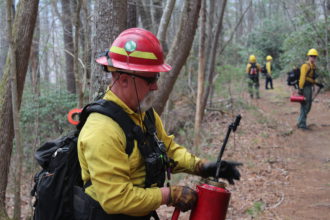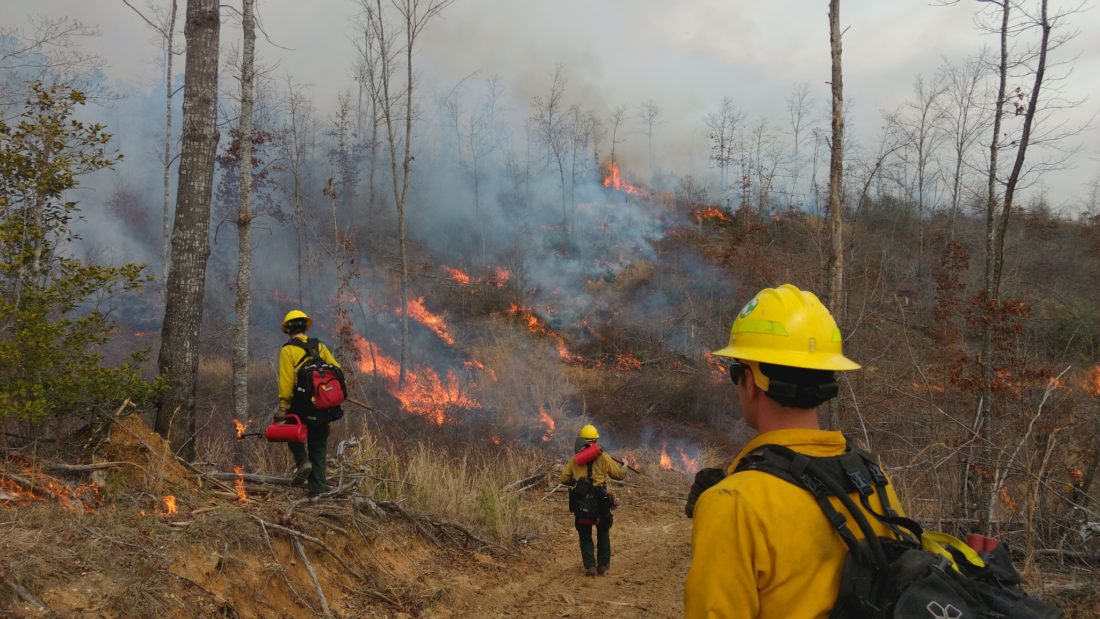For tens of thousands of years, fires regularly burned in the Southern Blue Ridge. Then, about 100 years ago, “they suddenly cut off — just like a spigot,” says Craig Harper, professor and extension wildlife specialist at the University of Tennessee.
Harper calls this dramatic change the “Smokey Bear” effect. “You can see all of these fires that occurred through the 17th and 18th centuries and into the early 19th century,” he says. But starting near the turn of the 20th century, federal government agencies began to prioritize fire protection and started extinguishing the flames, leading to a rapid drop-off in fire incidents.
Data from dendrochronology (tree-ring dating) studies, says Harper, show that the historical frequency of fires on south- or west-facing slopes in the Southern Appalachians was three to 10 years. Those past wildfires were started naturally by lightning, as well as manually by Native Americans and settlers.
The modern era of fire suppression has two major ecological impacts. First, it increases the intensity of wildfires. “The longer you suppress fire, the more intense it’s going to be, and the less able it is to be controlled by firefighters when it does burn,” says Adam Warwick, stewardship manager with The Nature Conservancy.
Second, cutting off fires threatens the variety of species that make Western North Carolina’s forests so unique. Warwick puts it bluntly: “Fire suppression is one of the greatest threats globally to biodiversity.”
Enter prescribed burning, wildfires that are intentionally set — and controlled — in a predetermined area. Land managers turn to prescribed burning to do the jobs that natural wildfires accomplished for so many years.
But some people worry about the consequences of prescribed burning, such as the killing of wildlife, says Warwick. That’s why he, along with his co-author Harper, recently released a publication titled “Considerations for Wildlife and Fire in the Southern Blue Ridge,” which combines more than 60 years of research with the hands-on experience of area land managers. The publication shows what healthy forests with a natural fire regime look like so “folks can decide for themselves,” Warwick explains.
Diversity and disturbance
Harper notes that negative public perception about prescribed burning generally arises from a lack of understanding about how fire benefits the landscape. “Many people will argue for increased diversity on national forests, but they don’t want disturbance,” he says. “If you don’t have disturbance, then it is impossible to have increased diversity. You are going to have a stagnant vegetation community.”
For example, Warwick says, a common belief is that prescribed burning during turkey nesting season burns up turkey nests. Instead, burns actually create new habitat for mother hens to raise their broods.
Chris Coxen, a district biologist for the National Wild Turkey Federation, explains that fire burns away some of a forest’s overstory, allowing sunlight onto the forest floor. That helps maintain good grass cover, which protects turkeys from predators and provides an optimal environment for the bugs that the birds eat.
Coxen adds that hens are more likely to nest in recently burned areas than in other habitats. “That has to do with hens being able to see into the forest and feel more protected,” he says.
But it’s not just wild turkeys that stand to gain from prescribed burns. “There is empirical evidence — from the red-cockaded woodpecker to the mountain golden heather to lots of grasses and legumes — that large groups of species tend to benefit from fire,” says Josh Kelly, public lands biologist with MountainTrue.
“Fire influences the structure of ecosystems by killing off some of the plants in the ecosystem,” Kelly continues. “In a broad sense, fire acts as a bit of a filter against fire-sensitive species that are normally found in moist areas but can become very competitive in the absence of fire.”
When those competitive species are tamed by fire, more sunlight is available to the rest of the ecosystem. This sunlight stimulates the growth of the herbaceous plants and young trees that grazing wildlife like.
For a local display of this dynamic in action, “go to Bent Creek to the power line right of way where they mow. See the wildflowers and grasses and the pollinator and bird diversity,” suggests Warwick. “That’s the result of a disturbance process. Mowing is sort of a surrogate for fire.”
Fire on the mountain

Prescribed burning can also benefit the region’s human population, Warwick says. “We saw with the fall of 2016 that all vegetation is going to burn at some point,” he notes. But a series of small, intentional burns can prevent a blaze that’s too intense to control.
When dry leaves and flammable shrubs such as mountain laurel and rhododendron are allowed to build up in the forest — and experience dangerous weather conditions of low humidity, high temperatures and strong winds — the resulting fires can be catastrophic. “It will happen again,” says Warwick. “I don’t know if it will be this spring or next fall, but it will happen.”
Historically, south- and west-facing slopes and ridgelines below 4,500 feet burned very frequently in the area. Today, people are building on those ridgetops and steep slopes. “The biggest risk factor homeowners face is when they build on top of ridges,” says Warwick. “I tell people, ‘The better view you have, the more at risk you are of having a wildfire burn down your house.’”
Warwick directs people to two organizations, Fire Adapted Communities and Firewise USA, that help homeowners and landowners learn about lessening their risk of losing property — or even their lives — in a fire.
Sparking change
Lisa Jennings is a natural resource specialist for the Grandfather Ranger District of Pisgah National Forest, which spans from Black Mountain to Blowing Rock. Jennings says that the land in her district is drier and hotter than that across much of Western North Carolina. Because of those conditions, the district has a long history of fire.
Historically, fires were especially prevalent within the Linville Gorge area, which receives the most lightning strikes of anywhere in the state. “Linville Gorge is our hot spot of wildfire history,” says Jennings. “Large-scale wildfires would have occurred every three to seven years before human settlement.”
Under an initiative called the Grandfather Restoration Project, Jennings and her team are bringing fire back to the landscape through prescribed burns on 6,000 acres per year. “We are going out there with assistance from a helicopter, and we are lighting low-intensity fires to remove the leaf litter and twigs and some of the understory vegetation that has grown up in these forest landscapes,” she says.
The effort proved its worth in 2016. “You didn’t see the large fires on the Grandfather Ranger District [that we saw in Gatlinburg, Tenn.],” says Jennings. “We had a few fires that were started in areas where we’d had a prescribed burn, and we were able to control those within hours instead of weeks.”




Before you comment
The comments section is here to provide a platform for civil dialogue on the issues we face together as a local community. Xpress is committed to offering this platform for all voices, but when the tone of the discussion gets nasty or strays off topic, we believe many people choose not to participate. Xpress editors are determined to moderate comments to ensure a constructive interchange is maintained. All comments judged not to be in keeping with the spirit of civil discourse will be removed and repeat violators will be banned. See here for our terms of service. Thank you for being part of this effort to promote respectful discussion.